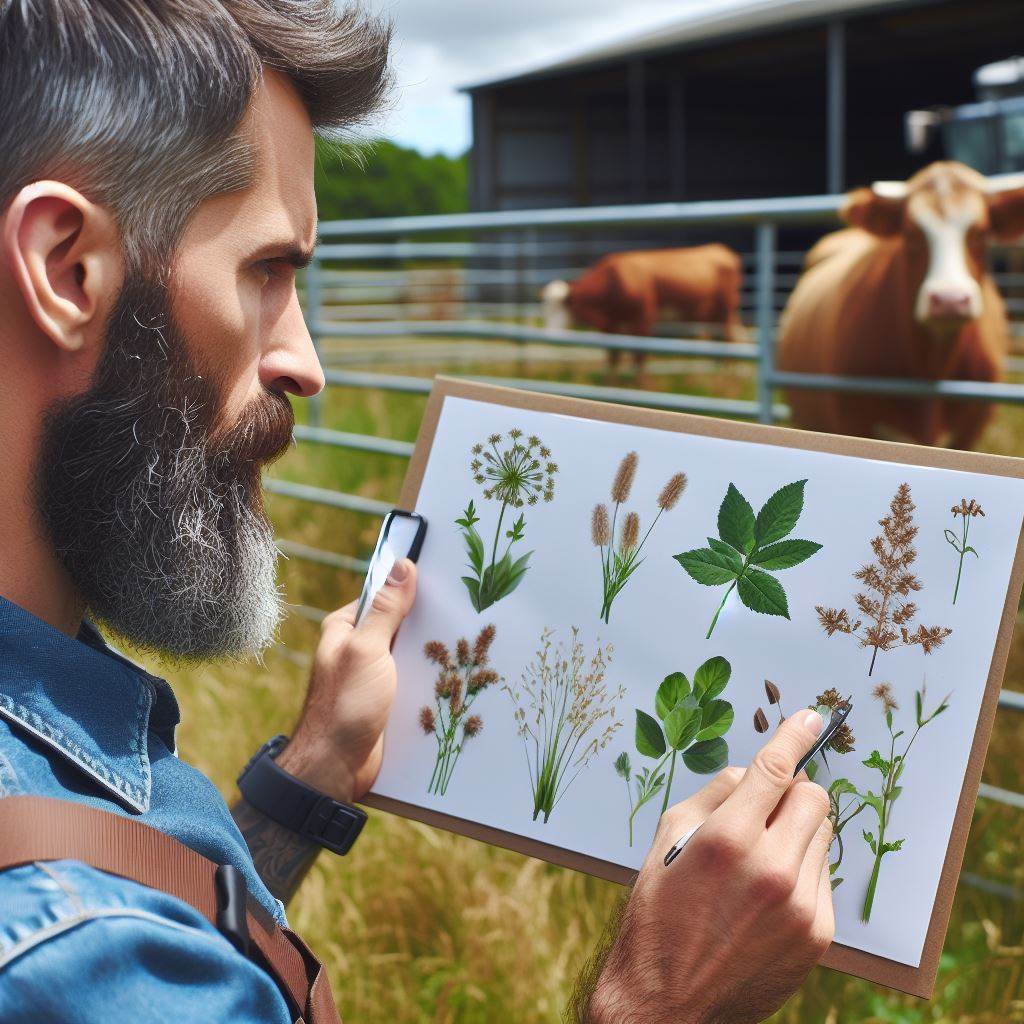Introduction
In the realm of pasture management, the significance of identifying and controlling weeds cannot be overstated.
Maintaining a weed-free pasture is fundamental for ensuring the health of livestock and the quality of forage.
Weeds, if left unchecked, bring a cascade of negative impacts:
They diminish the nutritional value of forage, leading to suboptimal livestock diets.
Certain weeds are toxic, posing direct health risks to grazing animals.
The competitive nature of weeds results in lower overall forage productivity.
Economically, weeds contribute to increased feed costs and potential veterinary expenses.
This section delves into the critical aspects of identifying and controlling pasture weeds.
By understanding their impact and implementing effective control measures, farmers can foster a healthier and more productive pasture environment, benefiting both livestock and the overall agricultural operation.
Identification of Common Pasture Weeds
Description and characteristics of key weeds
Dandelion (Taraxacum officinale)
Dandelions are small yellow flowers with a circular shape and grow in clusters.
They have a deep taproot.
Dandelions are perennial weeds, meaning they come back year after year.
One unique identifying feature of dandelions is their white puffy seed heads that disperse with the wind.
Thistles (Cirsium spp. and Carduus spp.)
Thistles can vary in appearance depending on the species but are generally tall with spiky leaves and purple or pink flowers.
It can be either annuals or perennials, with some species having deep taproots.
Transform Your Agribusiness
Unlock your farm's potential with expert advice tailored to your needs. Get actionable steps that drive real results.
Get StartedOne unique identifying feature of thistles is their prickly leaves and flower heads.
Chicory (Cichorium intybus)
Chicory has bright blue flowers and elongated leaves with a toothed edge.
It is a perennial weed that can grow up to 3 feet tall.
One unique identifying feature of chicory is its milky white sap that oozes out when stems or leaves are broken.
Importance of accurate weed identification for effective control strategies
Accurate weed identification is crucial for developing effective control strategies in pasture management.
Knowing the specific weeds present in a pasture allows for targeted control methods to be implemented.
Different weeds may require different control measures, such as herbicides or manual removal.
Misidentifying weeds can lead to wasted time, effort, and resources by using ineffective control methods.
Accurate identification also helps in monitoring weed populations and assessing the success of control efforts.
By knowing the life cycle and growth habits of specific weeds, farmers or pasture managers can implement control measures at the right time, thus preventing the weeds from spreading and competing with desirable forage species.
In addition, some weeds may have toxic properties or cause allergic reactions in animals, making accurate identification essential to protect livestock health.
Furthermore, understanding the unique features and characteristics of different weeds can aid in prevention and early detection, allowing for proactive management practices.
Overall, accurate weed identification is the first step towards effective weed control and plays a vital role in maintaining healthy and productive pasture ecosystems.
Read: Erosion Control in Grazing Lands
Impacts of Pasture Weeds on Livestock and Forage
Pasture weeds can have significant impacts on the overall health and productivity of livestock and forage.
Understanding these impacts is vital for effective weed management in pasture systems.
Competitive advantage of weeds over desirable forage
Weeds possess attributes that give them a competitive advantage over desirable forage plants.
They often have rapid growth rates, high seed production, and effective strategies for surviving and spreading.
These traits enable weeds to outcompete desirable forage plants for essential resources like water, nutrients, and sunlight.
As a result, the presence of weeds in pastures can decrease the availability and quality of forage for livestock.
Nutritional deficiencies caused by certain weeds
Some pasture weeds can directly impact the nutritional balance of livestock diets.
Certain weed species, such as curly dock and pigweed, have high levels of oxalates, which can bind to calcium and reduce its absorption.
This reduced calcium availability can lead to nutritional deficiencies, particularly in grazing animals reliant on pasture as a primary food source.
Livestock may experience conditions like milk fever, weakened bone structure, and impaired growth.
Showcase Your Farming Business
Publish your professional farming services profile on our blog for a one-time fee of $200 and reach a dedicated audience of farmers and agribusiness owners.
Publish Your ProfileDecreased livestock performance and weight gain due to weed presence
The presence of weeds in pastures can directly impact livestock performance and weight gain.
Weeds compete with desirable forage plants for space and resources, resulting in lower availability and quality of forage.
When livestock consume a diet with limited access to high-quality forage, their overall nutritional intake may be compromised.
This can lead to decreased performance, lower weight gain, and reduced milk production in lactating animals.
Economic losses associated with reduced forage quality
Reduced forage quality due to weed presence can have significant economic implications for livestock producers.
Lower-quality forage can result in increased feeding costs and the need for additional supplementation.
Moreover, decreased livestock performance and weight gain associated with weed-infested pastures can lead to reduced market value for animals.
Therefore, pasture weed control is essential to minimize economic losses and maintain a profitable livestock operation.
Therefore, pasture weeds have various negative impacts on both livestock and forage.
They outcompete desirable forage for essential resources, cause nutritional deficiencies, decrease livestock performance and weight gain, and result in economic losses.
Implementing effective weed management strategies is crucial to ensure the health and productivity of both livestock and pasture systems.
Read: Boosting Pasture Yield: Top Techniques

Effective Control Methods
Cultural control practices
Weeds can be effectively managed through the implementation of cultural control practices.
Mowing techniques and frequency play a crucial role in weed control.
By employing various mowing techniques, such as rotary mowers or flail mowers, and adjusting the frequency based on weed growth, the spread and persistence of weeds can be significantly reduced.
Regular mowing helps to prevent weeds from flowering and producing seeds, ultimately limiting their population in pastures.
Grazing management strategies also play a vital role in weed control.
Proper grazing practices, such as controlled grazing periods, rotational grazing, or strip grazing, allow for better utilization of forages by livestock, minimizing the availability of resources for weeds to establish and grow.
Furthermore, strategic grazing can help disrupt weed growth cycles, depriving them of their competitive advantage.
Chemical control options
Chemical control methods can be an effective tool in managing pasture weeds.
Selective herbicides, specifically designed to target specific weed species while leaving desired forage unharmed, are available in the market.
These herbicides can be applied using various methods, including foliar sprays or spot treatments.
However, it is essential to carefully read and follow label instructions when using herbicides to avoid unintended damage to the pasture or livestock.
Proper application techniques and precautions are crucial for successful chemical control.
When applying herbicides, factors such as weather conditions, weed growth stage, and mixing ratios need to be considered.
Additionally, appropriate protective equipment should be worn to ensure the safety of the applicator and prevent herbicide drift.
Adhering to recommended application rates and timings will help achieve maximum control while minimizing the environmental impact.
Biological control measures
Biological control offers an alternative approach to managing pasture weeds.
Introducing natural enemies of weeds, such as insects or diseases, can help suppress their growth.
These natural enemies feed on weeds, either by consuming plant tissues or disrupting their life cycle.
Biocontrol agents, when used appropriately, can provide long-term control by reducing weed populations and limiting their spread.
However, careful consideration should be given to the potential impact on non-target plant species.
Integrated weed management approaches
An integrated approach to weed management combines various control methods to achieve sustainable weed control while maintaining healthy pastures.
Integrated weed management strategies involve the simultaneous use of cultural, chemical, and biological controls.
By integrating different control methods, weed populations can be effectively managed, while minimizing herbicide use and promoting ecological balance.
To implement an integrated weed management program, it is crucial to regularly monitor pasture conditions, identify weed species, and choose appropriate control methods based on the specific weed infestation.
Combining cultural practices, such as mowing and grazing management, with chemical and biological control measures tailored to the specific weed species, will provide a comprehensive and effective approach to long-term weed control.
In essence, effective control of pasture weeds requires an integrated approach.
Cultural control practices, including different mowing techniques and grazing management strategies, are essential in preventing weed growth.
Chemical control options, such as selective herbicides and proper application techniques, can be used to target specific weed species.
Showcase Your Farming Business
Publish your professional farming services profile on our blog for a one-time fee of $200 and reach a dedicated audience of farmers and agribusiness owners.
Publish Your ProfileMeanwhile, biological control measures, like the introduction of natural enemies, provide additional support in suppressing weed growth.
By implementing an integrated weed management approach, pasture owners can achieve sustainable and long-term control over weeds, promoting healthy and productive pastures.
Read: Livestock Health: Pasture-Based Tips
Find Out More: Aquaculture Genetics: Better Fish Breeding
Preventing Weed Infestations in Pastures
A well-maintained pasture is crucial for livestock health and productivity.
Implementing effective prevention measures can help control weed infestations and maintain a healthy grazing environment.
Here are some strategies to consider:
Proper Pasture Establishment and Management
- Ensure adequate soil fertility and pH levels for optimal pasture growth.
- Implement proper mowing and grazing practices to discourage weed establishment.
- Rotate livestock to prevent overgrazing and allow for pasture recovery.
- Avoid excessive soil disturbance that can promote weed seed germination.
Regular Monitoring and Early Detection of Weed Populations
- Regularly inspect pastures to identify potential weed infestations at an early stage.
- Train staff or educate yourself on common weed species and their characteristics.
- Act promptly upon sighting weed populations to prevent further spread.
Seed Selection Considerations
- Choose high-quality forage seed mixes that are free from weed contamination.
- Ensure the selected seeds are appropriate for your specific pasture conditions and purpose.
- Obtain seeds from reputable sources known for producing weed-free products.
- Consider using certified weed-free forage seed if available.
Quarantine Measures for Introduced Animals or Equipment
- Establish a quarantine area for new animals or machinery entering the pasture.
- Inspect and clean any equipment or vehicles before introducing them to the pasture.
- Monitor new arrivals closely to prevent the introduction and spread of weed seeds.
- Keep records of all introduced animals or equipment for future reference.
By implementing these preventive measures, you can greatly reduce the risk of weed infestations in your pastures.
This will not only benefit your livestock but also contribute to the overall health and productivity of the grazing land.
Remember, prevention is key when it comes to weed control.
Be proactive, stay vigilant, and take the necessary steps to maintain a weed-free pasture environment.
Read: Essential Equipment for Modern Pig Farms
Conclusion
Identifying and controlling pasture weeds plays a crucial role in maintaining healthy and productive pastures.
It is essential for farmers to be proactive and take measures to keep their pastures weed-free.
By regularly monitoring and identifying weeds, farmers can prevent the spread and impact of invasive species on their livestock and forage.
Implementing effective control measures such as mowing, grazing management, and herbicide application can help in reducing weed populations.
Additionally, engaging in proper pasture management practices, such as proper fertilization and irrigation, can promote desirable forage growth and reduce weed competition.
To ensure the success of weed management strategies, it is advisable for farmers to seek professional advice or access resources that offer guidance on weed identification and control methods.
Local agricultural extension offices, agricultural consultants, or universities often provide valuable information on specific weed species in the area and recommend appropriate control measures based on their expertise.
By partnering with experts in weed management, farmers can effectively combat weed infestations and maintain healthy, productive pastures.
By recognizing the importance of pasture weed identification and taking proactive measures to control them, farmers can ensure the overall health and productivity of their pastures and livestock.
Weeds should not be underestimated and should be managed properly to maintain the quality and abundance of desirable forage.
Let us all take action and seek professional advice or resources to effectively manage weeds and improve our pasture lands for sustainable farming practices.




